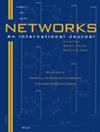一致生产路线问题
IF 1.3
4区 计算机科学
Q4 COMPUTER SCIENCE, HARDWARE & ARCHITECTURE
引用次数: 1
摘要
本文介绍了在具有多个工厂和产品的环境中的一致生产路线问题。问题在于找到符合特定一致性要求的最低成本生产路线计划。在我们的上下文中,一致性被定义为解决方案的某些特定特征随时间保持不变的程度。我们考虑四种形式的一致性,即:驱动因素、来源、产品和工厂一致性。对于这些一致性要求中的每一个,都有一个目标最大值来定义决策者对完全一致解决方案偏差的容忍度。这些目标是作为软约束来执行的,在优化集成生产和路线计划时,需要将违反软约束的情况降至最低。我们提出了该问题的数学公式和精确的分支和切割算法,并通过有效的不等式和特定的分支优先级进行了增强。我们还提出了一种基于迭代局部搜索和几个数学规划组件的启发式求解方法。在一组新引入的大型基准实例上进行的实验表明,这些增强大大提高了精确算法的性能,启发式方法对具有不同一致性要求的生产路线问题以及问题的标准版本都表现得很稳健。我们还分析了解决方案的成本一致性权衡,证实了在不过度增加成本的情况下实施一致性是可能的。结果还揭示了在优化和测量我们研究的一致性特征时第一个时间段的影响。本文章由计算机程序翻译,如有差异,请以英文原文为准。
The consistent production routing problem
This article introduces the consistent production routing problem in a setting with multiple plants and products. The problem consists in finding minimum‐cost production‐routing plans that also meet specific consistency requirements. In our context, consistency is defined as the degree to which some specified features of the solution remain invariant over time. We consider four forms of consistency, namely: driver, source, product, and plant consistency. For each of these consistency requirements, there is a target maximum value defining the decision‐maker's tolerance to deviations from a perfectly consistent solution. These targets are enforced as soft constraints whose violations need to be minimized when optimizing the integrated production and routing plan. We present a mathematical formulation for the problem and an exact branch‐and‐cut algorithm, enhanced with valid inequalities and specific branching priorities. We also propose a heuristic solution method based on iterated local search and several mathematical programming components. Experiments on a large benchmark set of newly introduced instances show that the enhancements substantially improve the performance of the exact algorithm and that the heuristic method performs robustly for production routing problems with different consistency requirements as well as for standard versions of the problem. We also analyze the cost‐consistency trade‐off of the solutions, confirming that it is possible to impose consistency without excessively increasing the cost. The results also reveal the impact of the first time period when optimizing and measuring the consistency features we study.
求助全文
通过发布文献求助,成功后即可免费获取论文全文。
去求助
来源期刊

Networks
工程技术-计算机:硬件
CiteScore
4.40
自引率
9.50%
发文量
46
审稿时长
12 months
期刊介绍:
Network problems are pervasive in our modern technological society, as witnessed by our reliance on physical networks that provide power, communication, and transportation. As well, a number of processes can be modeled using logical networks, as in the scheduling of interdependent tasks, the dating of archaeological artifacts, or the compilation of subroutines comprising a large computer program. Networks provide a common framework for posing and studying problems that often have wider applicability than their originating context.
The goal of this journal is to provide a central forum for the distribution of timely information about network problems, their design and mathematical analysis, as well as efficient algorithms for carrying out optimization on networks. The nonstandard modeling of diverse processes using networks and network concepts is also of interest. Consequently, the disciplines that are useful in studying networks are varied, including applied mathematics, operations research, computer science, discrete mathematics, and economics.
Networks publishes material on the analytic modeling of problems using networks, the mathematical analysis of network problems, the design of computationally efficient network algorithms, and innovative case studies of successful network applications. We do not typically publish works that fall in the realm of pure graph theory (without significant algorithmic and modeling contributions) or papers that deal with engineering aspects of network design. Since the audience for this journal is then necessarily broad, articles that impact multiple application areas or that creatively use new or existing methodologies are especially appropriate. We seek to publish original, well-written research papers that make a substantive contribution to the knowledge base. In addition, tutorial and survey articles are welcomed. All manuscripts are carefully refereed.
 求助内容:
求助内容: 应助结果提醒方式:
应助结果提醒方式:


